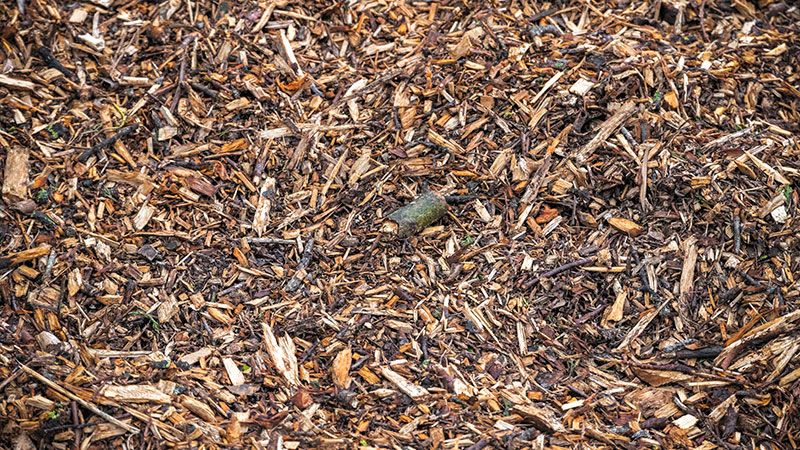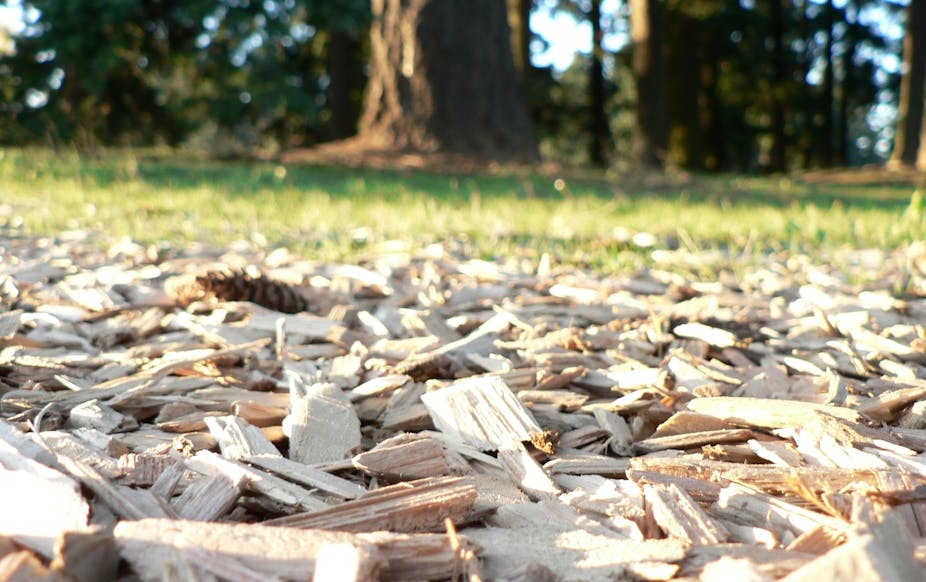Discover the truth about wood chips in the garden. With over 20 years of hands-on experience, Darrell Smith of DH Garden Centre in Vancouver shares how to use wood chips the right way for healthier soil, stronger plants, and a thriving garden.
The Story That Changed Everything
Twenty years ago, I made one of the biggest mistakes of my gardening career. I had read that wood chips were a great mulch, so I did what seemed logical: I tilled them directly into my sandy soil. Within weeks, my vegetables began to yellow, their growth slowed, and my once-promising garden looked like it was starving.
At the time, I believed the critics: “Wood chips are garden killers. They rob your soil of nitrogen and choke your plants.” And in that moment, I agreed.
But over the years, I refused to give up on them. Slowly, through trial, error, and a lot of wheelbarrow loads, I discovered the truth: it wasn’t the wood chips that were the problem, it was how I was using them.
When I stopped mixing them into the soil and started layering them on top, everything changed. Fungi spread, humus formed, and my sandy ground slowly turned into rich, dark, living earth. I could dig down with my hands and feel the difference—moisture, worms, and crumbly humus where once there had only been lifeless dust.
Today, after decades of experimenting, I can say with confidence: wood chips in the garden are one of the most powerful soil-healing tools you can use if you know how to apply them.

Wood chips in the garden are one of the most powerful soil-healing tools you can use if you know how to apply them.
Myth vs. Truth: The Real Story Behind Wood Chips
Wood chips in the garden have long been misunderstood. For decades, many gardeners avoided them, convinced they were harmful. But modern horticultural science and thousands of backyard experiments like mine tell a different story.
-
The myth: Wood chips “steal” nitrogen from plants.
-
The truth: Nitrogen loss only happens if you till wood chips into the soil. When layered on top, the chips stay on the surface, breaking down slowly while feeding fungi—not robbing your vegetables.
-
The myth: Wood chips only look good but don’t improve soil.
-
The truth: Over time, layered wood chips decompose into humus, enriching soil structure, retaining moisture, and supporting healthy microbial life.
-
The myth: Wood chips cause disease or harm roots.
-
The truth: With proper use, they suppress weeds, regulate temperature, and even prevent many plant stresses.
Why Layering, Not Mixing, Makes All the Difference
The way you use wood chips in the garden determines whether they become your worst enemy or your greatest ally.
When mixed directly into the soil, the chips disrupt the nitrogen balance. Soil microbes “borrow” nitrogen to break down the carbon-heavy chips, leaving your plants starved.
But when applied as a top layer mulch, the story changes:
-
The chips break down slowly on the surface.
-
Fungi colonize them, creating underground networks that support plant roots.
-
Earthworms pull bits of decomposed chips into the soil naturally—at a pace the ecosystem can handle.
In other words, layering wood chips mimics the forest floor. And if you’ve ever walked through a lush forest, you know the kind of abundance that system creates.

In other words, layering wood chips mimics the forest floor. And if you’ve ever walked through a lush forest, you know the kind of abundance that system creates.
Best Uses for Wood Chips in the Garden
After decades of trial and error, here’s what I’ve learned about where wood chips shine the most:
1. Perennials, Fruit Trees, and Shrubs
Perennials love fungal-dominant soil, and wood chips are the perfect way to encourage fungal growth. Fruit trees, berry bushes, grapes, and even perennial herbs thrive when mulched with chips.
2. Fruiting Crops Like Tomatoes and Cucumbers
Wood chips regulate moisture levels, which is crucial for crops prone to blossom end rot, like tomatoes. A thick layer prevents soil from drying out too fast while keeping the root zone consistently cool.
3. Soil Transformation Over Time
With repeated layers year after year, wood chips break down into humus, improving sandy soils, breaking up clay, and creating a living ecosystem where plants can thrive.
Where Wood Chips Don’t Work as Well
That said, wood chips aren’t a one-size-fits-all solution.
-
Quick annuals: Crops like lettuce, radishes, and carrots need rapid nutrient cycling. Leaf mulch, grass clippings, or composted straw are better here.
-
Seedling beds: Fresh wood chips can be too coarse and may block tiny seedlings from emerging. Save chips for mature plants.
-
Certain woods: Avoid using black walnut chips, which release juglone, toxic to many plants. Fresh cedar can also slow down seedlings. Stick to pine, oak, maple, or mixed arborist chips.

Fresh wood chips can be too coarse and may block tiny seedlings from emerging. Save chips for mature plants.
Wood Chips and the Fungal Advantage
One of the greatest benefits of wood chips in the garden is their ability to foster fungal networks. Unlike bacteria, which dominate in soils fed by green material like grass and compost, fungi thrive on woody carbon.
And fungi aren’t just decomposers—they’re collaborators. Mycorrhizal fungi form symbiotic relationships with plant roots, extending their reach for water and nutrients. When you mulch with wood chips, you’re feeding this hidden underground web that makes your garden more resilient.
The Long Game: Building Soil Year After Year
Perhaps the most profound lesson wood chips have taught me is patience. The first year you lay them down, you might not notice much. By the second year, you’ll see better moisture retention and fewer weeds. By the third and fourth, you’ll start digging into rich, black humus that smells like the forest floor.
And the best part? You don’t need to remove old chips. Simply keep layering year after year. Each layer compounds the effect, building soil fertility naturally.
Common Mistakes to Avoid
Even after all these years, I still see gardeners in Vancouver making the same mistakes I made early on:
-
Tilling wood chips into the soil. Never do this—it causes nitrogen lockup.
-
Using only one thin layer. A skim coat won’t do much. Apply 3–4 inches thick for real results.
-
Expecting instant results. Wood chips are about the long game. Their power is in soil transformation over time.
-
Choosing the wrong wood. Avoid walnut and fresh cedar; opt for mixed arborist chips when possible.
Darell’s Take After 20 Years
“I’ve put down thousands of wheelbarrows of wood chips over the decades, and the miracle never stops. Where there was once lifeless sand, I can now dig into rich, crumbly humus. That transformation is why I’ll always defend wood chips—used the right way, they heal soil better than anything else.”

Using only one thin layer. A skim coat won’t do much. Apply 3–4 inches thick for real results.
FAQs About Wood Chips in the Garden
1. Do wood chips in the garden really steal nitrogen?
Only if you till them into the soil. As a surface mulch, they don’t harm your plants.
2. How thick should I apply wood chips?
Aim for 3–4 inches for best results. Too thin won’t suppress weeds or hold moisture effectively.
3. Are wood chips safe for vegetable gardens?
Yes—for established crops, especially fruiting vegetables. For quick annuals, use leaf mulch instead.
4. What kind of wood chips are best?
Pine, oak, maple, and mixed arborist chips are excellent. Avoid walnut and fresh cedar.
5. How long before wood chips improve soil?
You’ll notice benefits in year one (weed suppression, moisture retention), but the real soil transformation begins after 2–3 years of consistent layering.
Final Call to Action
At DH Garden Centre in Vancouver, we’ve seen firsthand how wood chips can transform struggling gardens into thriving ecosystems. Whether you’re starting fresh, battling sandy soil, or trying to keep fruit trees happy, we can help you choose the right mulch for your needs.
📍 Visit us at 3742 West 10th Avenue, Vancouver, BC
📞 Call us at 604-929-7335
🌐 Explore more at dhgardencentre.com
Let’s turn your soil into living earth—one layer of wood chips at a time.


